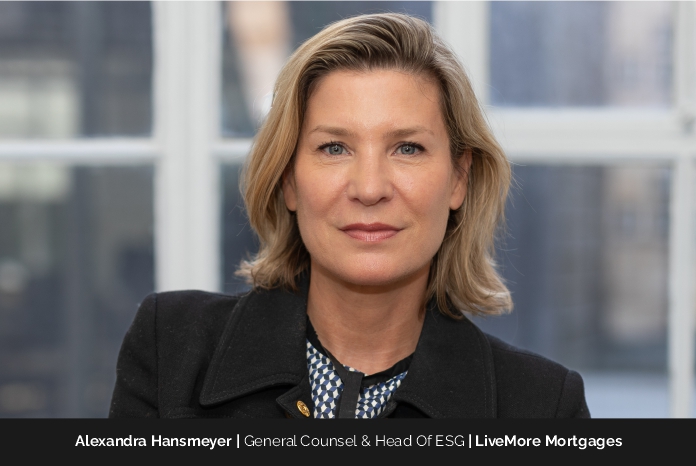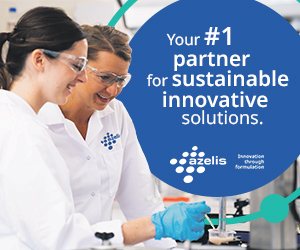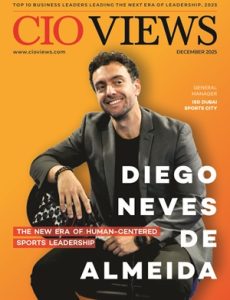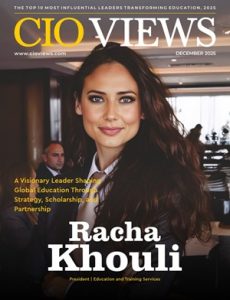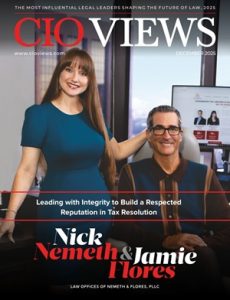Dr. Alexandra Hansmeyer, General Counsel and Head of ESG at LiveMore Mortgages, is a proficient legal leader with experience in the UK, Germany, and China. She completed her Doctorate in Law (PhD) from the University of Hamburg and is a Solicitor (England and Wales) from BPP Law School, London. She has held senior level legal positions at renowned companies, thriving in a fast-paced environment. She holds a track record of negotiating complex contracts, managing cross-border mergers and acquisition transactions, and boosting innovation to enable operational efficiencies. She is known for transforming corporate strategies by shaping environmental, social, and governance principles (ESG), assisting organisations in sustainable growth. She emphasises the usage of technological advancements to improve performance, implement AI driven solutions, and better decision making.
When Dr Hansmeyer encountered LiveMore Mortgages in 2020, she was inspired by its mission to disrupt the later-life mortgage market for the benefit of older borrowers, and she wanted to be a part of that.
Dr. Hansmeyer says, “LiveMore was founded on a clear social purpose. This is not an add on, it is fundamental to the way we operate and the reason we are here.”
LiveMore Mortgages is a specialist mortgage lender dedicated to supporting borrowers in later life. Whether one wants to secure their first home, a subsequent home or a remortgage, LiveMore provides tailored support and clear guidance to its customers. The company firmly believes that later life mortgages help people enjoy their life, rather than limiting it.
Focusing on Sustainable Growth
Dr. Hansmeyer has always been motivated by the conviction that law can be a powerful tool for systemic change. Growing up in Germany, she grew up with a strong environmental and social awareness. The Green Party was gaining power and, as a nation, they were already recycling, not using plastic bags, saving energy, and focused a lot on social and environmental issues.
She entered the legal profession to stand by what’s right and achieve justice. The growing ESG movement has further built on her ability to provide principles and tools for individuals and companies to help make the world a better place.
Working with LiveMore Mortgages
LiveMore’s focus is on lending beyond retirement. In the UK, older mortgage applicants are often excluded from accessing the finance they need, mainly because the automation used by most lenders cannot assess, often-complex, later-life incomes. This creates a barrier to lending into retirement on standard mortgage products. LiveMore was created to rectify this and make standard mortgage lending more readily available to people over 50 and throughout retirement.
Dr Hansmeyer saw the opportunity to talk about the social purpose at the heart of the business and established the role of Head of ESG, alongside her existing role as General Counsel. As Head of ESG, she has developed LiveMore’s Social Bond Framework, taking it from inception to a point where LiveMore is recognised by the capital markets.
Its entire standard-mortgage lending book addresses the International Capital Market Association’s (ICMA) requirements for a Social Project. Each Social Project has to meet a defined underserved population, and one of those is ‘ageing populations.’
Dr. Hansmeyer says, “We are proud to be one of the very few UK mortgage lenders offering ICMA-led social bonds. This is more than a transaction, it’s a signal of what capital markets can and should do.”
Freedom in Retirement
As part of its commitment to the Social Bond Framework, LiveMore continually refines both its products and underwriting processes to better meet the needs of later-life borrowers. Its focus goes beyond financial inclusion to encompass customer wellbeing and tailored support for vulnerable customers. Many of the people they serve face significant challenges, including the risk of losing their homes later in life.
Dr. Hansmeyer says, “Social purpose isn’t an add on, it’s our starting point. We just have to do it. We need to see the opportunities and just do it.”
Thinking creatively and acting empathetically are central to LiveMore’s mission, – giving people freedom in retirement and the dignity of financial security.
LiveMore designs eligibility around ageing populations, then operationalises the processes. For example, manual underwriting for complex incomes, combined with manual review with sophisticated decision engines, AI-driven learning models, and proprietary datasets. They have no maximum age on key products, and their oldest borrower is now over 90 years old.
Navigating Through Dual Responsibilities
While navigating through her dual responsibilities of legal oversight and ESG leadership, she thinks of the dual role as an opportunity, as ESG and legal dovetail exactly. She believes that putting in place ESG principles is the same as following other tenets of the law.
Legal oversight provides a natural vantage point from which to identify areas where ESG principles can be embedded throughout operations and strategy.
Being part of a fast-growing company that wants to grow in the right way, the focus is on governance and legal. As part of both the social and governance parts of ESG, the team has established a specific vulnerability committee, with a focus on ensuring vulnerable customers are catered for responsibly, as well as ensuring LiveMore has the strongest levels of data protection.
Dr. Hansmeyer says, “I hope to leave a legacy defined by integration – the conviction that legal integrity, ethical responsibility, and sustainability are not competing priorities but mutually reinforcing ones.”
As regulations evolve, ESG grows alongside them, enabling her to anticipate emerging requirements and integrate them seamlessly into their governance structure with a benefit to all.
Overcoming Challenges
Dr. Hansmeyer states that embedding ESG requires creating broad-based awareness across the company, both amongst the leadership team and every member of staff. Operationally, there were two challenges that the company overcame. First was personalised underwriting instead of automation. LiveMore leverages technology-enabled common sense by combining manual underwriting judgment with AI and data-driven insights, ensuring scalability.
Dr. Hansmeyer says, “I hope our efforts [to make financial services more inclusive for older people], will contribute to a financial system where social purpose is not peripheral but integral to investment and lending decisions.”
Later-life affordability often involves pensions, annuities, investments and part-time work, elements many automated underwriting models either rule out or do not put enough weight on. LiveMore insists on manual underwriting so that a borrower’s unique circumstances are captured and an individual’s needs can be catered for.
Secondly, it puts robust operational structures around clients’ potential vulnerability, ensuring the highest-possible standards. It then made it procedural, establishing a monthly Vulnerable Customer Committee, structured forbearance and vulnerability tracking, so it survives leadership changes and ensures quality for every borrower.
In addition, LiveMore focuses on the education of mortgage advisers. Advisers have been largely unaware of the range of borrowing solutions for older people and the role they play in fulfilling a social need.
On the environmental side, the link between home energy efficiency and property value has the potential to drive the large-scale retrofitting of UK homes, yet there is still a lack of large-scale government thinking which slows progress. Green mortgage products are still in their infancy, with uptake below expectations. Improved data sources will be key to future advances, i.e. more reliable energy performance certificates (EPCs), smart metering, and risk overlays which are necessary to accurately assess property-level carbon exposure.
Strategic Time Utilisation
Dr. Hansmeyer states that as the business scales, legal governance increasingly demands her time, making it essential to schedule dedicated moments for ESG. She says it can be challenging to remain disciplined, but her passion for sustainability ensures that she always returns to it with renewed energy. She dedicates time each week to reflect on their ESG roadmap, engage with colleagues, and drive forward specific initiatives, even when legal matters dominate the agenda.
Defining Success
Success for Dr. Hansmeyer lies in ensuring that LiveMore is well-positioned for future transitions. In the UK, lenders will soon be required to report environmental data as part of the Government’s Net Zero commitment, and she wants LiveMore to lead in this space.
Collaborating with technology teams to integrate ESG into their data architecture is vital. She wants to upscale technology that allows LiveMore to directly identify relevant energy performance and climate data at the point of origination to enable them to further develop an informed ESG growth strategy on an ongoing basis.
Beyond environmental metrics, the team has a strong emphasis on developing social instruments, namely their Social Bond Framework. These initiatives expand the ESG dialogue beyond the narrow focus on ‘green’ products and highlight the importance of socially inclusive financial innovation offered by private, not just public institutions.
Social Bonds are not as prominent as Green Bonds in the European market, although their issuance has steadily increased in recent years. As data from Structured Credit Investor (SCI) shows, social labelled bonds continue to make up the smallest slice in ESG, representing only 28.6% of the share (with retail mortgage-backed securities (RMBS) deals accounting for 40% of that category), compared to 71.4% of green deals.
Dr. Hansmeyer believes that one way of measuring LiveMore’s success is increasing awareness for this rather overlooked “social” segment by aligning their securitisations with the Social Bond Principles.
In addition, they measure social outcomes through access and inclusion, such as by tracking their percentage of lending to the ICMA target population. LiveMore also tracks the age profile of their borrowers, average loan size and percentages allocated to eligible project categories.
The team has also taken responsibility for their operational carbon emissions by purchasing verified carbon credits from a ‘native forests and grasslands’ conservation project.
Stakeholder Engagement
Dr. Hansmeyer also believes that stakeholder engagement is fundamental, as they need buy-in from all. Once the team sets the ESG policy they ensure the workforce is aware and engaged. They facilitate this by keeping data up-to-date and providing regular reports.
She relies on a variety of teams providing her with this data. Internally, this includes credit risk, HR, servicing, and the management team. Externally, it includes their clients and the capital markets as they are interested in the ESG performance of the LiveMore Social Bond. She then engages regularly with underwriting for qualitative signals, servicing – for vulnerability data, capital markets investors for impact questions, employee workforce for operational ESG data and both the ESG and main board committees that set policy.
For capital markets, LiveMore publishes Social Bond Impact Reports and provides climate-risk data for its securitisation portfolios, which enhances investor confidence and attracts sustainability-focused capital.
The team has noticed a wider investor interest in ESG factors in the European securitisation market, as the overall market shows signs of recovery. In LiveMore’s second social securitisation deal in June 2025, they noticed that not only did more investors appear with ESG questionnaires, but the depth and breadth of those questionnaires was significantly expanded – a positive development that the team facilitated by being able to deliver meaningful data.
Customer Stories
Dr. Hansmeyer feels a real sense of achievement listening to amazing customer stories, often from people stuck in really difficult situations, who LiveMore was able to help. The lives of each of these people were improved through greater access to fair financial products. These individual outcomes are, in many ways, the truest measure of success, which is incredibly rewarding.
Nick, 58, faced rejection from mainstream lenders due to his irregular income post-COVID. Despite being confident in his ability to repay, he was close to losing his home. LiveMore’s flexible approach to affordability, taking into account both a grant and self-employed income, enabled him to secure a mortgage. He described the experience as “a breath of fresh air” and praised the human touch in LiveMore’s service.
In the second story, Alan, 73, a widower recovering from surgery, faced legal and financial complications with his mortgage. LiveMore’s compassionate and tailored support helped him navigate these challenges and regain control over his housing situation.
Notable Achievements
Other than a constant stream of satisfied customers, Dr Hansmeyer’s other proudest achievements were launching two securitisations aligned with the ICMA Social Bond Principles, which received a second party opinion confirming their contribution to UN Sustainable Development Goals. This represented a tangible synthesis of legal precision and sustainability.
As the ESG sphere is expanding rapidly, especially in Europe, Dr. Hansmeyer remains engaged through conferences, panels, and ongoing dialogue with peers across the industry. These forums are invaluable for keeping abreast of regulatory developments and emerging best practices. They also provide a space to test ideas and refine LiveMore’s strategy in ways that balance compliance with innovation.
Advice for Legal Professionals
Dr. Hansmeyer advises other legal professionals to embrace ESG with confidence. The field operates within a structured framework of laws, principles, and reporting standards, all of which align naturally with legal training.
She says, “Lawyers are well-equipped to translate complexity into clarity, to anticipate regulatory developments, and to build resilient frameworks, all of which are required for a successful ESG strategy. ESG requires both analytical rigour and moral imagination, and the legal profession provides a strong foundation for both these things.”
Furthermore, she advises people responsible for ESG to build frameworks, controls and audit trails, so they can both measure and monitor on an ongoing basis. She advises, “Build processes to provide you and your company with the data you need so you are not starting from scratch every time, then automate the data collection so it’s easy for someone else to continue the project.”
She also advises legal professionals to keep abreast of new developments. ESG is an area that is developing rapidly, particularly in Europe. There are numerous new developments and regulations, so those responsible for ESG need to watch the direction the market is going in and keep educating themselves to keep ahead of it.
Conclusion
Dr. Hansmeyer believes that LiveMore’s impact extends beyond the mortgage industry. They are creating awareness in the market that ESG is about more than just the environmental impacts and that there are social opportunities too, all within a strict governance framework.
By broadening financial inclusion for older borrowers and embedding ESG principles into capital markets, they are helping to shift norms around how financial institutions value social outcomes. Over time, she hopes their efforts will contribute to a financial system where social purpose is not peripheral but integral to investment and lending decisions. They are driving the market to make positive changes. A societal change in favour of older people is LiveMore’s purpose, and they believe that by creating awareness, others will follow in their footsteps.
She hopes to leave a legacy defined by integration – the conviction that legal integrity, ethical responsibility, and sustainability are not competing priorities but mutually reinforcing ones.
She feels that if in her career, she has helped demonstrate that business success can be aligned with social equity and environmental stewardship, then she will feel that her efforts have been worthwhile. She wishes to showcase that there is an opportunity for other people and companies to define good and show that everyone is capable of making a difference.
